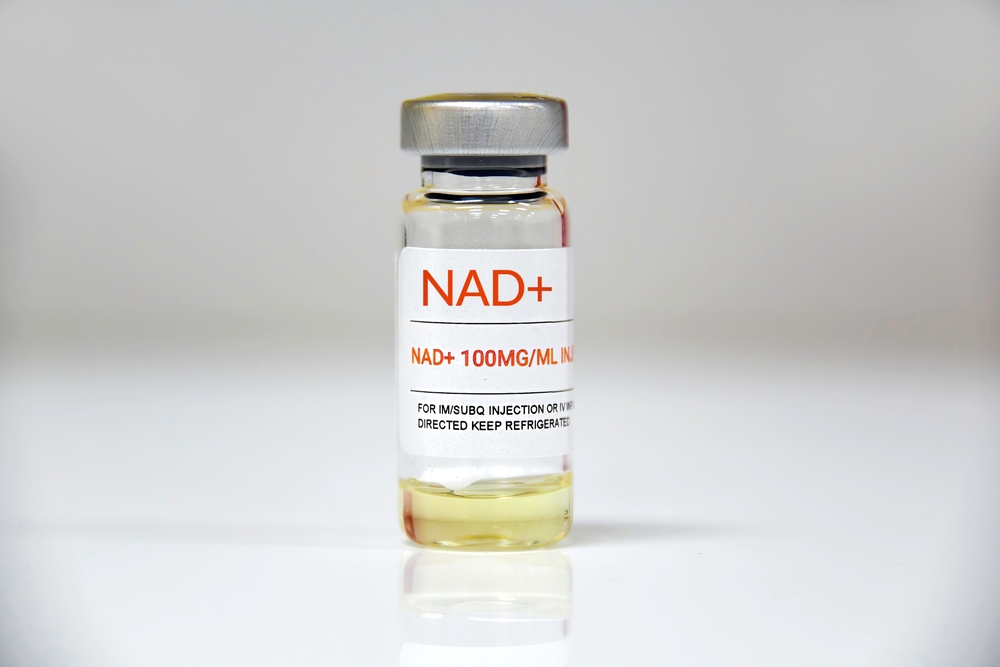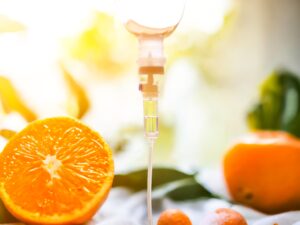Aging is a paradox; we gain things like wisdom, confidence, and a stronger sense of self, but we also face tradeoffs like cognitive decline, aging skin, a slower metabolism, and longer recovery from just about everything.
Sure, there are lifestyle changes and supplements that can help with longevity. There are also medical aesthetics like Botox, dermal fillers, and skin lasers. These things are all great. However, most only scratch the surface (often, literally).
Most anti-aging solutions can’t target the root cause of aging because that happens inside your cells. To promote longevity and slow aging at a cellular level, your body needs NAD⁺.
The good news? Your body naturally makes this molecule. The bad news? Your levels decline with age and certain lifestyle factors. Thankfully, there are ways to restore NAD⁺ and support your body’s natural ability to repair, regenerate, and function like it did when you were younger.
The most effective being NAD+ therapy. There’s a lot of chatter about NAD⁺. Many are even calling NAD+ injections and infusions a “miracle cure” for promoting longevity and slowing down aging.
Yes, that’s a bold claim, but honestly, we don’t disagree entirely.
While NAD+ is not a drug (it’s a natural molecule in your body) or a true anti-aging “miracle,” it has garnered significant attention due to its ability to help restore the natural decline of NAD that can lead to everything from visible signs of aging, to slower metabolism, low energy, and certain age-related health concerns.
Once you get to the end of this article, with a clear understanding of what NAD⁺ is, how it works in the body, and what science says about maintaining optimal levels, we think you’ll also agree that NAD+ isn’t just another wellness buzzword— it’s one of the most promising developments in longevity science.
What Exactly Is NAD+?
NAD+ (short for Nicotinamide Adenine Dinucleotide) is one of the most important molecules in your body. It’s found in every single living cell and is responsible for several essential functions—the most important being:
- Energy production – NAD+ plays a critical role in converting the food you eat into usable cellular energy (ATP). It’s essential for powering everything your body does—from breathing and digestion to brain function and muscle movement.
- Cellular repair – NAD+ supports enzymes that repair internal damage within cells, helping to maintain their structure, efficiency, and resilience over time.
- DNA damage response – NAD+ fuels enzymes that detect and repair broken or mutated DNA strands, which helps protect your cells from aging-related damage and mutations.
Essentially, NAD⁺ activates the systems that help your cells function properly, repair themselves, and stay resilient as you age. NAD+ is essential for your health. Without enough, your body will struggle to maintain energy, repair damage, and defend itself against daily stressors.
Over time, low NAD⁺ can make you more vulnerable to oxidative stress, chronic inflammation, and reduced cellular repair capacity. This might show up as fine lines, wrinkles, and loss of firmness. It might also present as fatigue, brain fog, a slower metabolism, and reduced muscle strength and recovery.
Unfortunately, NAD+ isn’t something you have an endless supply of. Your natural levels start to decline with age. By the time you hit middle age, your NAD+ stores may be half of what they were in your twenties.
But it’s not just age that slows NAD+ production. Even people in their 20s and 30s can experience low levels of NAD+. That’s because NAD+ production can also decline faster with stress, poor sleep, exposure to toxins, alcohol, or chronic illness.
NAD+ decline is inevitable. But thankfully, we’re living in a time when science has made it possible to restore NAD+ levels and actively support healthier aging from the inside out.
How NAD+ Works in the Body to Help Slow Down Aging
NAD+ helps slow the aging process by supporting your cells’ natural repair systems. It works as a coenzyme that helps critical enzymes function and do their jobs. Two of the most important groups of enzymes that depend on NAD+ are sirtuins and PARPs.
Sirtuins are proteins linked to longevity. They help regulate inflammation, support mitochondrial health, maintain DNA stability, and improve how your cells respond to stress. PARPs are enzymes responsible for repairing damaged DNA.
Every day, your cells face damage from things like UV exposure, pollution, inflammation, and metabolic stress. When this damage builds up faster than your body can repair it, the result is cellular dysfunction—what we experience as aging.
Both sirtuins and PARPs have to have NAD+ to do their jobs. Without enough of it, DNA repair slows down, damaged cells accumulate, and the body becomes less efficient at managing stress and inflammation.
Over time, this contributes to a gradual breakdown in how cells function—a process known as cellular decline. This is the underlying driver of many age-related changes, both visible (like skin aging) and invisible (like reduced organ and metabolic function).
NAD+ plays a central role in slowing this decline. When levels are sufficient, your body is better able to repair DNA, control inflammation, protect against oxidative stress, and maintain healthy cellular activity.
As NAD+ levels drop with age, as well as from factors like stress, poor sleep, toxin exposure, and illness, these repair and defense systems weaken. Restoring NAD+ levels can help re-activate these protective pathways.
This is what we mean by cell and DNA repair and support at a cellular level. NAD+ doesn’t just patch over the symptoms of aging—it supports your body’s ability to repair, regenerate, and bounce back at the cellular level.
Why NAD+ Matters for Longevity and Aging
NAD+ is essential for long-term health, resilience, and graceful aging. It fuels your cells’ ability to repair damage, maintain energy, and stay functional as you age. Without enough NAD+, your body becomes more vulnerable to inflammation, oxidative stress, and the breakdown of systems we often associate with aging.
To truly support healthy aging and longevity, you have to start at the cellular level—and that’s exactly where NAD+ works. Instead of simply masking signs of aging, NAD+ helps your cells function better from the inside out.
Next, we will deep-dive a little further and review some of the latest studies on NAD+ and its potential as a longevity enhancer. But here are two areas where NAD+ has shown strong evidence of supporting age-related health:
Muscle Preservation
As we age, it’s common to lose muscle mass and strength. This can lead to a slower metabolism and weight gain, but can also impact your energy and overall physical function.
NAD+ helps support muscle health by improving mitochondrial performance and activating repair processes in muscle stem cells. In both animal and very early human studies, restoring NAD+ levels has been shown to enhance muscle regeneration and endurance, making it an important tool in maintaining a healthy weight, strength, and mobility with age.
Skin Health and Repair
Skin is one of the first places we notice signs of aging. NAD+ supports skin health by helping skin cells repair DNA damage, defend against environmental stressors like UV rays, and preserve the integrity of collagen and elastin.
Research shows that higher NAD+ levels may improve hydration, elasticity, and the skin’s natural ability to renew itself, leading to a healthier, more youthful appearance over time.
Other Promising Areas of Research
In addition to muscle and skin, scientists are actively exploring other ways NAD+ may influence aging and longevity. While these areas are still being studied, early research suggests potential benefits for:
- Cognitive function
- Metabolic health
- Cardiovascular health
- Immune function
All of these areas show promise, but it is important to note that more human research is needed to confirm consistent effects. Still, they represent an exciting era in longevity science and further highlight just how central NAD+ is to maintaining whole-body health as we age.
What Does Science Say About NAD+ Therapy?
The role of NAD+ in aging has become a major focus in longevity research. Scientists are exploring how boosting NAD+ levels may slow or even reverse aspects of aging by enhancing the body’s natural repair systems.
One of the most prominent researchers in this field is Dr. David Sinclair, a professor of genetics at Harvard Medical School. His lab has focused on several areas of epigenetic and metabolic aging. One being how NAD+ levels naturally decline with age, leading to reduced activity of sirtuins, which is a family of proteins that help regulate cellular health, DNA repair, and stress resistance.
Sinclair’s research suggests that restoring NAD+ levels can re-activate sirtuins, which may slow the aging process at the cellular level and improve resilience. His lab has demonstrated that increasing NAD+ in animal models through precursors like NMN (nicotinamide mononucleotide) can lead to:
- Improved mitochondrial function
- Enhanced DNA repair
- Better muscle endurance
- Increased resistance to metabolic and oxidative stress
- Even partial age reversal in tissues
In one study, Sinclair’s team used gene therapy in mice to reset the epigenetic clock, effectively reprogramming cells to a more youthful state. This points to a future where NAD+-based interventions could help restore function to aging tissues (not just slow their decline.)
In terms of broader human studies, Dr. Sinclair’s lab has begun human clinical trials to investigate the effects of nicotinamide mononucleotide (NMN), a precursor to NAD+, on various health parameters. We are anxious to see whether these early findings in animals translate to measurable improvements in human aging, metabolic health, and cellular function.
While Dr. Sinclair’s human studies are still in progress, other researchers have conducted human clinical trials on NAD+ precursors like nicotinamide riboside (NR) and NMN. For instance, one study found that chronic NR supplementation was well-tolerated and effectively increased NAD+ levels in healthy middle-aged and older adults.
Additionally, mechanistic research (a type of research that seeks to understand how something works at a cellular or molecular level) also supports NAD+’s role in skin repair, finding that NAD+ helps maintain skin health by supporting DNA repair, improving barrier function, and reducing oxidative stress—all of which are key factors in skin aging.
Though the field is still evolving and long-term human trials are still needed, the momentum behind NAD+ research continues to grow, and current research supports the idea that maintaining or restoring NAD+ levels may be a promising strategy for promoting healthier aging.
How to Elevate NAD+ Levels for Longevity and Healthy Aging
Lifestyle Interventions
There are some lifestyle changes, such as lifting weights, consuming certain nutrients and possibly following fasting protocols that some believe can help support NAD+ metabolism. While their effects will likely be modest compared to NAD+ medical therapies, everything you can do to support your body’s natural production and preservation of NAD+ adds up.
Topping the list is resistance training. If you don’t lift weights, engaging in regular resistance training has been shown to significantly increase muscle NAD+ and NADH concentrations, as well as enhance sirtuin activity and NAMPT protein levels.
There are also some foods that are considered NAD+ precursors. Consuming them might also contribute to maintaining healthy NAD+ levels. These include foods rich in vitamin B3 (niacin), such as milk and fermented products.
More research is needed to fully understand its impact on NAD+ levels, but intermittent fasting may also influence NAD+ metabolism by activating pathways associated with longevity, such as sirtuins. Some also claim that heath therapy may also stimulate pathways that support NAD+ production. However, current evidence is limited, and further studies are required to establish a direct link between heat (such as sauna use) and increased NAD+ levels.
NAD+ Oral Supplements
NAD+ supplements in oral forms, such as capsules or tablets, are available on the market. While research has shown that oral NAD+ precursors like NR and NMN are effective at raising NAD+ levels, there are several factors to consider.
The first is absorption issues. When taken orally, the bioavailability of NAD+ precursors can be limited. The body has to break down the supplement, and not all of it is efficiently absorbed into the bloodstream, meaning some of the benefits may be lost during digestion.
Another thing to consider is whether or not oral NAD+ is the most cost-effective. While NAD+ supplements can potentially increase NAD+ levels (assuming they come from a reputable company and contain clinically tested doses of NR or NMN), they are often not the most cost-effective solution.
Given that the body may only absorb a fraction of the dose, many people may need to take them regularly for extended periods to see the desired effects. This can become costly over time, especially when compared to other delivery methods like IV therapy or injections.
NAD+ IV Therapy and Injections
While oral NAD+ supplements might be of some help, they may not provide the same immediate or potent results that IV or injectable forms can offer. In clinical trials studying NAD+ precursors, the most effective delivery methods often involve direct infusion or injection.
NAD+ via IV or injection is often seen as the preferred route of administration, as both allow for more direct delivery of NAD+ into the bloodstream, typically making them more effective than oral supplements for several reasons.
NAD+ Intravenous (IV) Infusions
NAD+ IV infusions deliver NAD+ directly into the bloodstream, bypassing the digestive system entirely. This allows for much higher bioavailability and ensures that the body can access higher, more consistent levels of NAD+ for cellular repair, energy production, and other key functions.
The infusion process also ensures that the NAD+ is quickly absorbed and utilized by the body, often resulting in more noticeable benefits.
Injectable NAD+
For those who prefer to administer NAD+ at home, between clinic visits for IV infusions, or for convenience when traveling or maintaining consistent levels, injectable NAD+ is another option.
These injections are also absorbed more directly into the body compared to oral supplements, offering a more efficient way to boost NAD+ levels. Regular injections can provide a convenient and effective way to support healthy aging, energy, and overall wellness.
Bottom Line: While there are many options available to elevate NAD+ levels, it’s important to consider the method that works best for your needs and goals. Oral supplements like NR and NMN can be beneficial, but may not always be the most efficient or cost-effective solution due to absorption limitations.
For more direct and potent results, IV therapy and injections provide a powerful alternative, delivering NAD+ into your system quickly and effectively. At Revive Health Clinics nationwide, we offer NAD+ IV infusions and injections to help you maintain optimal NAD+ levels, support your cellular health, and promote healthy aging from the inside out.
FAQs About NAD+ Therapy
Is NAD+ Therapy Safe?
Yes, for most people, NAD+ therapy is considered safe when administered under medical supervision. It’s a naturally occurring molecule already present in your body, and replenishing it is generally well tolerated.
That said, it’s important to ensure you’re receiving the right dose and delivery method. As with any therapy, IV infusions or injections should be tailored to your needs and monitored by a qualified NAD+ healthcare provider.
Does NAD+ Therapy Have Side Effects or Risks?
Most people tolerate NAD+ therapy well, especially when it’s administered slowly and under clinical guidance. However, some people may experience mild, temporary side effects, particularly with IV infusions and injections.
These can include:
- Nausea
- Headache
- Flushing or warmth
- Abdominal discomfort
- Lightheadedness
These effects usually resolve quickly once the rate of infusion is adjusted or the session ends.
Is There Anyone Who Should Not Use NAD+ Therapy?
NAD+ therapy isn’t for everyone. People with certain medical conditions—including active cancer, severe liver or kidney disease, or those who are pregnant or breastfeeding—should consult a healthcare provider before starting NAD+ therapy.
Additionally, if you’re taking medications that affect mitochondrial function or energy metabolism, it’s especially important to speak with your doctor first. A full health assessment is always recommended before beginning NAD+ or any other longevity-focused therapy.
Do I Have to Take NAD+ Forever?
Not necessarily—but consistency matters. NAD+ levels naturally decline with age and stress, so ongoing support can help maintain cellular health and energy over time. Some people choose to do regular infusions or injections for maintenance, while others do short-term “resets” during periods of high stress or fatigue.
Think of NAD+ therapy as part of a long-term strategy for healthy aging. Your provider can help tailor a plan based on your needs, lifestyle, and goals.
Is NAD⁺ a Peptide?
Because both NAD⁺ and peptides are used to support longevity, energy, and cellular health, it’s easy to confuse them. And while they can work on overlapping biological pathways (such as inflammation and mitochondrial efficiency) they are made of entirely different building blocks and function in different ways.
Peptides are short chains of amino acids (essentially small proteins) that send signals to promote healing, regeneration, or cellular repair. NAD⁺ is a coenzyme, not a protein. It’s made from vitamin B3 (niacin) and plays a critical role in cellular energy production and repair. Niacin is converted inside the body through a metabolic process into NAD⁺, which fuels hundreds of reactions in your cells—especially those involved in mitochondrial function, DNA repair, and aging.
To learn more about peptide therapy, read “The Science of Peptide Therapy: How It Works and Why It Matters.”
Conclusion
Until a few years ago, we probably would’ve said the best you can do to promote overall longevity and slow aging is to eat clean, move your body, wear sunscreen, and get quality sleep. Then, of course, add in medical aesthetic treatments like Botox, dermal filler, and resurfacing lasers for a little extra help maintaining a youthful appearance.
But not anymore— you have several options within the functional medicine space, including peptide therapy, stem cells, and now NAD+.
At Relive Health, we are proud to be at the forefront of offering the most clinically-supported delivery methods of NAD+, including IV infusions and injectable options. To learn more or book your NAD+ therapy, check out our clinic locator to find a Relive Health Clinic that offers NAD+ near you.




